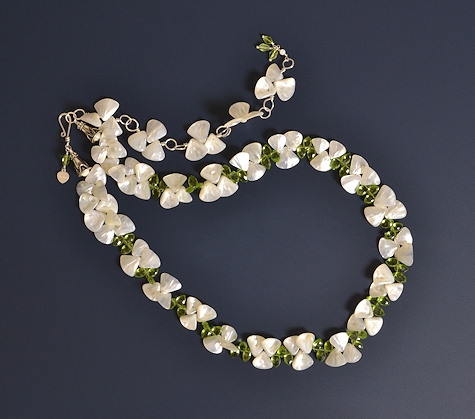Lovely bright mother of pearl wings frame bright faceted peridot briolettes in this pretty necklace. The shell is shaped into thin wings to take full advantage of its inner iridescent nacreous layer. Nacre is produced by certain molluscs and continuously deposited throughout the animal's life, protecting the creature by encysting parasites and debris. The encystation can produce a blister pearl on the inside of the shell or a free pearl within the tissue of the mantle. The iridescence arises from the structure of nacre rather than from coloring agents. Nacre consists of alternating platelets of aragonite (plain old calcium carbonate) separated by sheets of an organic, elastic matrix. In addition to being beautiful, this structure also makes nacre extremely tough. The colors arise because the aragonite platelets are about the same thickness as the wavelength of visible light. It is the interference pattern that produces the different color effects. The natural (?) concavity of these shells amplifies this colorful effect.
Peridot is a lovely green gem, somewhat under appreciated I think. While peridot is common (Egyptians made beads out of it 2,500 years ago), gem quality material is more rare. While searching for information about it for you, I came across this wonderful story by a geologist writing about a foray into the Leucite Hills in Wyoming where he was searching for olivine (of which peridot is an example) as an indicator of diamond deposits. He found 13,000 carats of largely flawless peridot in just two anthills! That's 5.7 pounds. Ants are famous for digging up garnets, but I hadn't heard of them mining peridot before! You have to scroll down to see a photo of part of his haul and click around on the page to find more fascinating information about peridot. Simmons calls it "little green nuggets of positive power." You will feel that yourself when you put this necklace on... just try to keep from smiling when you wear it! And may it bring you the abundance it is famous for!






